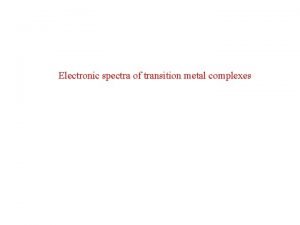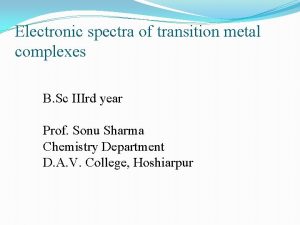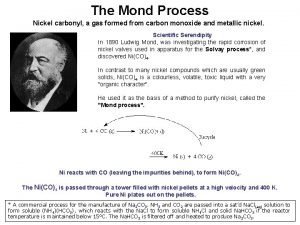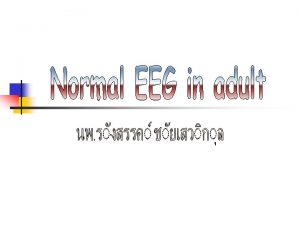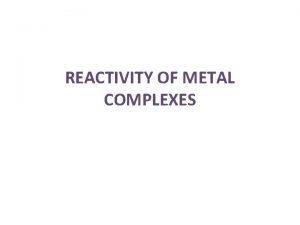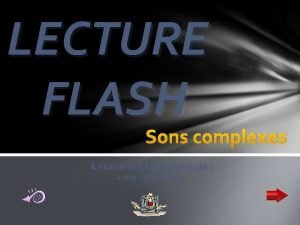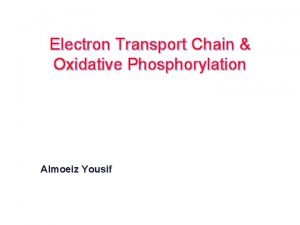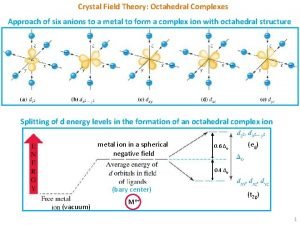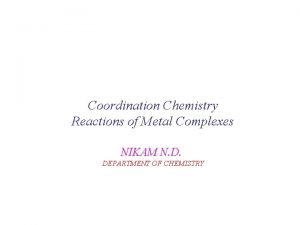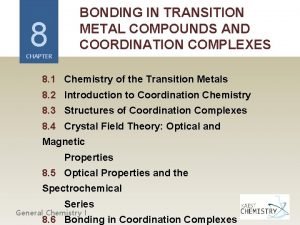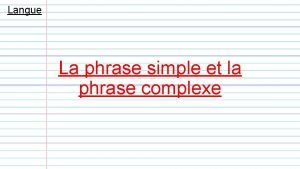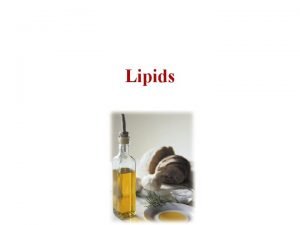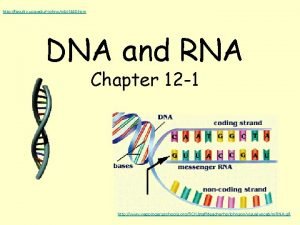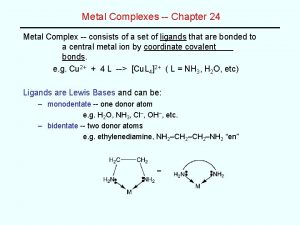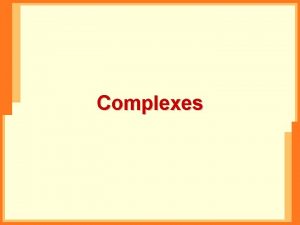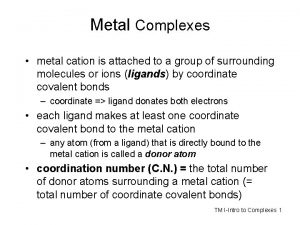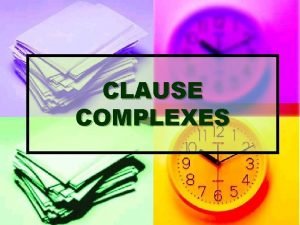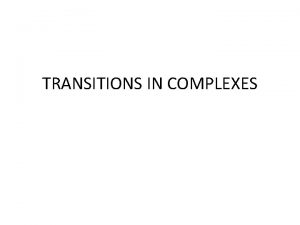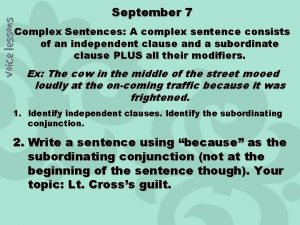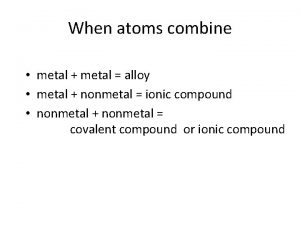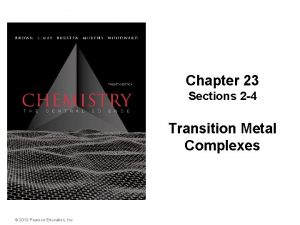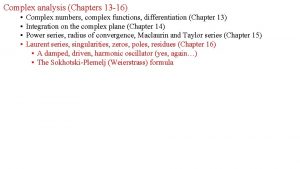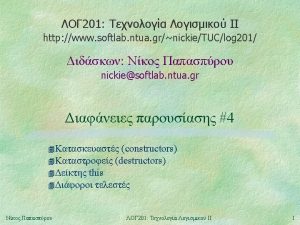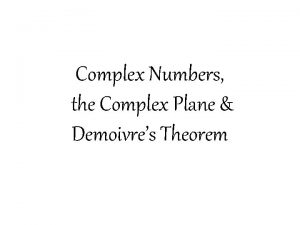Metal Complexes Chapter 24 Metal Complex consists of








![Answer 1. a) diiodoargentate(I) ion [I—Ag—I]– b) tris(ethylenediamine)cobalt(III) ion c) cis-[Co. Cl 2(en)2]Cl c) Answer 1. a) diiodoargentate(I) ion [I—Ag—I]– b) tris(ethylenediamine)cobalt(III) ion c) cis-[Co. Cl 2(en)2]Cl c)](https://slidetodoc.com/presentation_image/52d35daca694752e72bc4152cd309d5b/image-9.jpg)










![Sample Questions A complex [Co. A 6]3+ is red. The complex [Co. B 6]3+ Sample Questions A complex [Co. A 6]3+ is red. The complex [Co. B 6]3+](https://slidetodoc.com/presentation_image/52d35daca694752e72bc4152cd309d5b/image-20.jpg)
![Sample Questions A complex [Co. A 6]3+ is red. The complex [Co. B 6]3+ Sample Questions A complex [Co. A 6]3+ is red. The complex [Co. B 6]3+](https://slidetodoc.com/presentation_image/52d35daca694752e72bc4152cd309d5b/image-21.jpg)
- Slides: 21

Metal Complexes -- Chapter 24 Metal Complex -- consists of a set of ligands that are bonded to a central metal ion by coordinate covalent bonds. e. g. Cu 2+ + 4 L --> [Cu. L 4]2+ ( L = NH 3, H 2 O, etc) Ligands are Lewis Bases and can be: – monodentate -- one donor atom e. g. H 2 O, NH 3, Cl–, OH–, etc. – bidentate -- two donor atoms e. g. ethylenediamine, NH 2–CH 2–NH 2 “en”

Polydentate ligands – polydentate -- more than two donor atoms e. g. EDTA -- ethylenediaminetetraacetic acid (6 donor atoms) = EDTA 4–

Chelate Effect Chelate effect -- complexes with bi- or polydentate ligands are more stable than those with similar monodentate ligands e. g. [Ni(en)3]3+ is more stable than [Ni(NH 3)6]3+ Know Table 24. 2!

Writing Formulas of Complex Ions Metal ion first, then ligands. Charge outside brackets. total charge = sum of metal ion + ligands e. g. metal ion Cu 2+ Co 3+ Fe 3+ ligand H 2 O NH 3 CN– complex [Cu(H 2 O)]2+ [Co(NH 3)6]3+ [Fe(CN)6]3–

Nomenclature • 1. Name the ligands, put in alphabetical order. • 2. Add prefixes for ligands that appear more than once. • 3. Name the metal – Cationic complex; metal name – Anionic complex; metal prefix + ate • 4. Add oxidation state in roman numerals • 5. As separate word, write “ion” if not neutral, or list counterions (positive first, negative second). Examples: • Complex Name [Ni(CN)4]2– tetracyanonickelate(II) ion [Co. Cl 6]3– hexachlorocobaltate(III) ion [Co. Cl 2(NH 3)4]+ tetraaminedichlorocobalt(III) ion Na 3[Co(NO 2)6] sodium hexanitrocobaltate(III) [Cr. Cl 2(en)2]2 SO 4 dichlorobis(ethylenediamine)chromium(III) sulfate

Coordination Number and Structure Coordination # -- number of donor atoms attached to the metal center (a) Two-Coordinate Complexes -- linear structures Rare except for Ag+ e. g. [Ag(NH 3)2]+ and [Ag(CN)2]– (b) Four-Coordinate Complexes -- two structural types Tetrahedral structures -- common for ions with filled d subshells, e. g. Zn 2+ as in [Zn(OH)4]2–

More Coordination Number and Structure (b) Four-Coordinate Complexes -- two structural types square planar structures -- common for d 8 metal ions (Ni 2+, Pd 2+, Pt 2+) and for Cu 2+ e. g. (c) Six-Coordinate Complexes -- the most common! “always” octahedral structures, e. g.

Sample Problem 1. Give the name or formula, as required. Draw the structure of each complex. a) [Ag. I 2]– b) [Co(en)3]3+ c) cis-dichlorobis(ethylenediamine)cobalt(III) chloride d) sodium tetracyanonickelate(II)
![Answer 1 a diiodoargentateI ion IAgI b trisethylenediaminecobaltIII ion c cisCo Cl 2en2Cl c Answer 1. a) diiodoargentate(I) ion [I—Ag—I]– b) tris(ethylenediamine)cobalt(III) ion c) cis-[Co. Cl 2(en)2]Cl c)](https://slidetodoc.com/presentation_image/52d35daca694752e72bc4152cd309d5b/image-9.jpg)
Answer 1. a) diiodoargentate(I) ion [I—Ag—I]– b) tris(ethylenediamine)cobalt(III) ion c) cis-[Co. Cl 2(en)2]Cl c) Na 2[Ni(CN)4]

Structural Isomers of Coordination Complexes • Linkage isomers pentaamminenitrocobalt(II) ion pentaamminenitritocobalt(II) ion • Coordination isomers pentaamminechlorocobalt(II) bromide pentaamminebromocobalt(II) chloride

Isomerism; Overview 11

Stereoisomers of Coordination Complexes (a) Geometrical Isomers cis trans fac mer (b) Enantiomers Three common ways to get enantiomers: --chiral ligand --tetrahedral complex with 4 different groups --octahedral complexes with chelating ligands (and no mirror plane)

Sample Questions Draw a clear, 3 -dimensional structure of the geometrical isomer of Co(en)(NH 3)2 Cl 2 that is optically active. (define any abbreviations) Excess silver nitrate is added to a solution containing 0. 0522 mol of [Co(NH 3)4 Cl 2]Cl. How many g of Ag. Cl (FW = 143. 3) will precipitate?

Sample Questions Draw a clear, 3 -dimensional structure of the geometrical isomer of Co(en)(NH 3)2 Cl 2 that is optically active. (define any abbreviations) Excess silver nitrate is added to a solution containing 0. 0522 mol of [Co(NH 3)4 Cl 2]Cl. How many g of Ag. Cl (FW = 143. 3) will precipitate? 7. 48 g

Crystal Field Theory (Bonding in Transition Metal Complexes) Metal complexes are usually highly colored and are often paramagnetic -- such facts can be explained by a “d-orbital splitting diagram” dz 2 energy dx 2 -y 2 eg D = crystal field splitting energy dxz dyz t 2 g d orbitals of the metal ion in an octahedral field of ligands d orbitals of the free metal ion

Shape and Directionality of the d Orbitals eg D t 2 g

Crystal Field Strength The size of D depends on… • The nature of the ligand (ligand-metal bond strength!) “spectrochemical series” -- D decreases: CN– > NO 2– > en > NH 3 > H 2 O > OH– > F– > Cl– > Br– “strong field ligands” “weak field ligands” • The oxidation state of the metal (charge!) D is greater for M 3+ than for M 2+ • The row of the metal in the periodic table (size!) for a given ligand oxidation state of the metal, D increases going down in a group e. g. D is greater in Ru(NH 3)63+ than in Fe(NH 3)63+ Colors of metal complexes are due to electronic transition between the t 2 g and eg energy levels

d Orbital Splitting Diagrams for Octahedral Complexes dx 2–y 2 eg large D “low spin” small D “high spin” dxy dxz dyz Fe(H 2 O)62+ t 2 g dxy dxz dyz Fe(CN)64– t 2 g

High Spin vs. Low Spin CN– is a stronger field ligand than is H 2 O which leads to a greater D value (i. e. a greater d orbital splitting) As a result, • Fe(H 2 O)62+ is a “high spin” complex and is paramagnetic (4 unpaired electrons) while, • Fe(CN)64– is a “low spin” complex and is diamagnetic (no unpaired electrons) The CN– complex with the larger D value absorbs light of higher energy (i. e. higher frequency but shorter wavelength) OMIT … d orbital splitting diagrams for other geometries (i. e. tetrahedral and square planar)
![Sample Questions A complex Co A 63 is red The complex Co B 63 Sample Questions A complex [Co. A 6]3+ is red. The complex [Co. B 6]3+](https://slidetodoc.com/presentation_image/52d35daca694752e72bc4152cd309d5b/image-20.jpg)
Sample Questions A complex [Co. A 6]3+ is red. The complex [Co. B 6]3+ is green. a) Which ligand, A or B, produces the larger crystal field splitting D? b) If the two ligands are ammonia and water, which is A and which is B? c) Draw the d orbital diagram of either complex, assuming it is “high spin. ” How many unpaired electrons will it have? Give the order of increase of D in the following sets: a) Cr(NH 3)63+, Cr. Cl 63–, Cr(CN)63– b) Co(H 2 O)62+, Co(H 2 O)63+, Rh(H 2 O)63+
![Sample Questions A complex Co A 63 is red The complex Co B 63 Sample Questions A complex [Co. A 6]3+ is red. The complex [Co. B 6]3+](https://slidetodoc.com/presentation_image/52d35daca694752e72bc4152cd309d5b/image-21.jpg)
Sample Questions A complex [Co. A 6]3+ is red. The complex [Co. B 6]3+ is green. a) Which ligand, A or B, produces the larger crystal field splitting D? b) If the two ligands are ammonia and water, which is A and which is B? c) Draw the d orbital diagram of either complex, assuming it is “high spin. ” How many unpaired electrons will it have? eg a) A dz 2 dx 2 -y 2 b) A = NH 3, B = H 2 O c) 4 unpaired electrons dxy dxz dyz t 2 g Give the order of increase of D in the following sets: a) Cr(NH 3)63+, Cr. Cl 63–, Cr(CN)63– b) Co(H 2 O)62+, Co(H 2 O)63+, Rh(H 2 O)63+ a) Cr(CN)63– > Cr(NH 3)63+ > Cr. Cl 63– b) Rh(H 2 O)63+ > Co(H 2 O)62+
 Racah parameter and nephelauxetic effect
Racah parameter and nephelauxetic effect What is the mulliken symbols for f spectroscopic term in
What is the mulliken symbols for f spectroscopic term in Mond carbonyl process
Mond carbonyl process K complexes eeg
K complexes eeg Freud complexes
Freud complexes Example of labile complex
Example of labile complex Sian fain
Sian fain Uncouplers of oxidative phosphorylation
Uncouplers of oxidative phosphorylation Site:slidetodoc.com
Site:slidetodoc.com Inert and labile complexes
Inert and labile complexes Actinide contraction
Actinide contraction Ligand spectrochemical series
Ligand spectrochemical series Maquines complexes
Maquines complexes Exemples de phrases complexes
Exemples de phrases complexes Slidetodoc.com
Slidetodoc.com Spherical complexes of emulsified fats are known as
Spherical complexes of emulsified fats are known as Activated complex
Activated complex Modular man camps
Modular man camps A ________ is formed from beadlike histone-dna complexes.
A ________ is formed from beadlike histone-dna complexes. Pauline and bruno have a big argument
Pauline and bruno have a big argument Ghon complex
Ghon complex Simple, compound complex rules
Simple, compound complex rules
